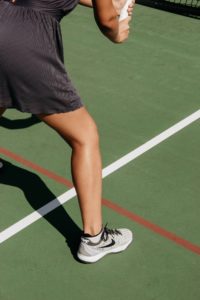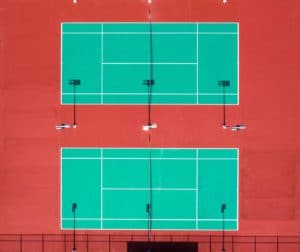If you are a totally beginner you are in the right place.
There is many points from where we can start to speak about.
Introduction
Tennis has been around as a game for thousands of years and is well enjoyed by many people all around the world. Regardless of ethnicity, social situation, and physical stature, people from every walk of life have been able to find enjoyment in this sport. Tennis has developed over time from the 12th-century handball game known as “Paume” to the racket-swinging sport we know and love today.
As you read through this guide, keep in mind that it will take time for you to learn the basics, so go easy on yourself. Enjoy the learning process as you read about your balance, where your legs should be, and how to hold your arms and position your hands. Without further ado, let’s delve into what you should know about tennis before you start playing tennis.
We Gonna Talk About
1: Your Balance
Your Balance
Balance is the most important aspect of tennis. You won’t get far if you aren’t able to get your balance down. The reason balance is so critical is because it can help you maintain a proper swing of your racket, as well as help you control the ball. After all, the point of tennis is to hit the ball exactly where you need it to go.
To prepare your body for the balance required while playing tennis, you have to forget every other aspect of balance you use in your everyday life. Balance in tennis is significantly different from this.
In life, we keep our balance by leaning into your arms and using them to adjust ourselves. In tennis, leaning actually hurts your form, which ends up hurting your game. The same is said if you lean into your legs. Your entire body will be thrown off balance and this can cause both tensions in your body and pain as you try to accomplish certain swings with your racket. So, why do you need to stop leaning in?
- As you lean when you’re getting ready to take a shot with the ball, you prevent the smooth flow of your movements.
- Your upper body is thrown out of alignment and your arms don’t have the power they need to swing or guide the racket properly. This causes you to have jerky, fast movements rather than trained, precise swings.
- As you lean, the angle of your racket changes as well, and this impacts how you hit the ball.
So, how exactly do you get the perfect balance during a game of tennis?
Your balance will allow you to quickly accelerate movement, decelerate movement, and change your positioning so you can hit the ball right where you want to. Balance in tennis means your entire body is in line, with all of its parts.
Each aspect of your body plays a role in your balance, from your upper body to your legs. They all need to be in line and communicating with each other to get your perfect balance. Instead of adjusting with your upper body, let your legs do the adjusting and support for you.
Tennis is luckily a game many people can play, despite their athletic prowess. But for anyone, balance is key. Some people will find their own balance naturally while others will need to work hard to maintain their balance on the court. However, practice will pay off once you find yourself adjusting your body and making those shots how you want them to play out. As you continue to read through this guide, you will see aspects of balance in the next few sections as well. To get you started, here are some tips as you begin to delve into balancing your body to set you up for success:
- Try practicing on a smaller tennis court at first. This way you can practice the balance you need and create muscle memory with the movements you need to make in order to accomplish the right pull-through for your shots. Take it slow at first and focus on simply getting the ball to the other side of the court. Then focus on getting the ball to specific areas on the other side of the court.
- Let your weight do its job naturally. As you focus on your balance, you will use your weight to line up your shots. Then you will also have the right amount of force when you use the right type of hand motion.
- Let your shoulders guide your arm as you move towards the shot you want to take, then let your legs do the work to maintain your balance instead of your upper body.
Spend the time you need on balance without getting overly frustrated with yourself. We all started somewhere, and you can only get better from this point forward.

2: Leg Position
Leg Position
In tennis, your legs are important to your performance. This includes your feet, your knees and everything in between. Your legs not only help control your balance, but they also help you make those quick changes in the acceleration and deceleration of your movement.
Instead of taking wide, large steps in tennis, you need to focus on smaller and more precise steps. That’s the most important thing in tennis when it comes to foot movement—being able to take small and precise steps that lend to your agility rather than take away from it. Small steps that are focused on adjusting your movements minutely serve your game better than larger steps that are taken without thought and make drastic changes to your body position and balance.
As you gear your feet in the right position, your legs should be slightly bent at the knees so that they keep you poised down low and ready to strike the ball when you need to.
Don’t keep your legs still. Keep them ready for movement at any moment so that you can follow the ball as it comes back towards your side of the court. When you are primed for movement, then you automatically become a more reactive player, which aids your game.
As you make movements and use your feet, focus on using the tip of your foot and your toes to aid with your efficiency in movement and lining up your shot. Remember that you need your body to be limber and dynamic. Your feet are important in controlling your movements.
Ever heard of the split-step? If you’re new to tennis, you probably haven’t. That’s okay. That’s why I am here, to help you learn everything that you can about the world of tennis.
A split-step is the movement you make as your opposing player hits the ball back towards you. The minute they hit the ball toward your end of the court, the jump and change of movement your feet quickly do is a split-step. This change of movement is usually followed by a short sprint so that you can get to the ball on time and adjust your balance. Practicing a split-step move and keeping your feet moving will allow you to keep that reaction speed at the level you want it at.
As we explore the importance of your legs, your feet aren’t the only thing you need to focus on. Your knees are as important to your tennis game as your feet are. It’s great if you have balance and you learn the right way to move your feet, but what happens if you don’t control your knees?
Your knees need to be taken care of like a newborn baby when you start playing tennis. Okay, maybe not that drastically but they do need some extra attention. Tennis is hard on the knees, so maintain proper positioning during the tennis game, and ensuring you take care of your legs before and after you play will keep your knees loose and limber for many games to come.
To ensure that your body stays in prime physical shape, make sure that you do warmups with your whole body (not only your legs, but give your legs a specific focus during warmups, as well). Warmups should be done even if you are only going to practice and not play a real match. A lot of strain can be put on the body during practices. By making sure that you warm up, your muscles and tendons will be better prepped for the movements your body will make as you play.
As you get into position and during game play, you want to keep your knees bent enough that it keeps your quadriceps ready and primed for movement. The last thing you want is your reaction time slowed down because you kept your legs straight. So, keep your knees bent and your legs moving so that the reaction time is cut down.
Do you see how your warmups are important to your game? When you keep your knees bent for so long and in constant movement, they can take a lot of strain if they are not ready for the exercise, and they will not give you the endurance that you need for the game.
Pro tip: Warming up your knees can be fairly easy to do. As you warm up, sit down and extend your legs in front of you. Using your hands on your knees, massage them in small circular motions to keep your knees limber and prepared for the game or practice ahead of you.
Tennis isn’t about running, so you don’t have to focus on running to meet the ball as it flies over to your side of the court. Instead, focus on which direction the ball is heading so your body can do those split-steps, knee movements and use of balance to make your targeted hit on the ball successful, sending it over to your opponent’s court.
As you prepare into the swing to hit the ball over, keep your feet in mind. You will always have a foot that is called the “control foot.” This is the foot that is in the direction you need to go to hit the ball. By having the control foot, you lessen your reaction time when the ball moves over to a certain end of the court. You want to be able to sprint back and forth easier and your foot positioning makes this possible. You see, there’s so much more to tennis than merely hitting a ball with your racket, but once you get it down, then you will find yourself sailing through the game, breaking a sweat, and having so much fun.

3: Your Arms and Hands
Your Arms and Hands
While your upper body isn’t the best thing to rely on in tennis for balance, your arms and hands are as important as your legs when it comes to making sure the ball goes where it needs to.
Your elbows, wrists, shoulders, and handgrip all play into how your reaction time and direction of shot pans outs. Remember to keep your elbow up higher than you’re used to because this will reduce the time you need to get it into a position to hit the ball. If prior to your swing, you have to extend your elbow up and out, you automatically place yourself at a disadvantage as your opponent can use your delayed reaction time against you.
Warming up your shoulders is vital before practice or a match because the very nature of the game of tennis means they are going to get a vigorous workout. Your shoulders will constantly be rotating and pulled back and forth as you aim your racket towards those balls for the perfect shot.
As you see the ball hurtling towards your end of the court, your shoulder should already be in movement to get your arm and hand extended to where the racket needs to be for the ball to hit it perfectly.
Don’t keep your wrist stiff or flexed in, as this controls your immediate swing of the racket. Make sure that your wrist is extended and prepared for the shot that it’s about to take. Your wrist will be the guiding force that pulls your arm up or sideways to guide your shot, let it take that lead.
Your grip on your racket matters as well. Control will help you win your games at the end of the day. Control over your balance, control over your leg and shoulder movements, and even control over your grip on your racket.
You need to make sure that you have a solid grip on the racket so that it doesn’t fly out of your hand when you extend your hand to meet the ball. You also want to make sure that the impact of the ball on the racket doesn’t rattle your arm.
So, how do you know when you have a perfect grip? Perfect grip means that your finger and palm position is the same before a hit as it is after the racket has been hit. If your hand movement is moved by the impact of the ball then you weren’t gripping the racket properly. You need to exercise both power over the racket and control over its movements.
The other important aspect of tennis when playing is to learn how to use your non-dominant hand. For most people, this is their left hand. However, for the lefties of the world, their right hand will be their non-dominant hand.
Have you ever watched a match of professional tennis being played? The players constantly switch up which hands they are using in order to keep those shots perfect and primed for their benefit rather than their opponents. Your non-dominant hand is also playing when you are holding the racket with your dominant hand.
How? Well, it’s simple. As you swing with your dominant hand, your other hand will help prep your forehand and help control your balance if you hit a backhand swing. It also will help you keep your balance as you volley and set up those overhead shots. Most importantly, your non-dominant hand brings balance when you serve and that can often set the tone for your entire game.
You need to get into the habit of focusing on your non-dominant hand during gameplay rather than ignoring that it is there. Ensuring that your other hand is balancing out your play is crucial to your success and your fun in the game. Also, having more balance ensures that less of our body takes stress during those harder hits and pull-throughs.

4: Tennis Tips
Tennis Tips
Okay, great, so you have the basics down. You know what you should and shouldn’t do. You are aware of what to pay attention to, where your legs should be, the importance of warmups for both the knees and the shoulders, and how to make your balance work best for your game. What about those lesser-known tips that everyone but you seems to know? As much as your body plays the main role in tennis, there are also other tips you could benefit from to use in your game and here they are:
- You don’t need the most expensive tennis racket out there. As you begin to play the game, pick out a standard size racket and feel your comfort level with this. You need your racket to match two things: your body and your grip. If the racket is too thick and heavy, you won’t be able to wield it properly in a game of tennis. And remember, a good racket is always worth re-stringing if one breaks.
- Don’t give up if you feel like you’re bad at tennis. We all had to start somewhere and with something. When it comes to tennis, practice truly does separate good players from the bad ones. If you put in enough practice, you will soon find that you become well acquainted with your racket, the court, and the game.
- Tennis lessons from a professional teacher aren’t a bad thing. They can improve your game faster and give you confidence as you go into those one-on-one games with friends and family.
- Before you play or practice, make sure that you warmup. And after every game, make sure you cool your body down with some exercises. Warmups and cooldowns can look the same, but make sure you’re not overexerting yourself. As you do these exercises, you should be stretching your arms and your legs, going for a light jog to loosen your muscles. During a cooldown, always end it with stretches.
- As you’re getting ready to hit the ball back, try to make sure you time it so that you hit the ball while it’s at the same height as your waist. This makes your reaction time quicker and is an easier position to hit the ball from. Conclusion
Congratulations, now you know a little bit more about your body and where it needs to be to succeed in tennis! It’s never easy learning a new sport, but understanding the role your body plays in the sport can make a vast difference as you dive into it. I wish you luck as you explore the relationship between your body and racket while you play tennis.
It can be an incredibly rewarding and fun sport to play, and on top of it, your body gets great exercise. Don’t be too hard on yourself! Relax, it’s your serve!




